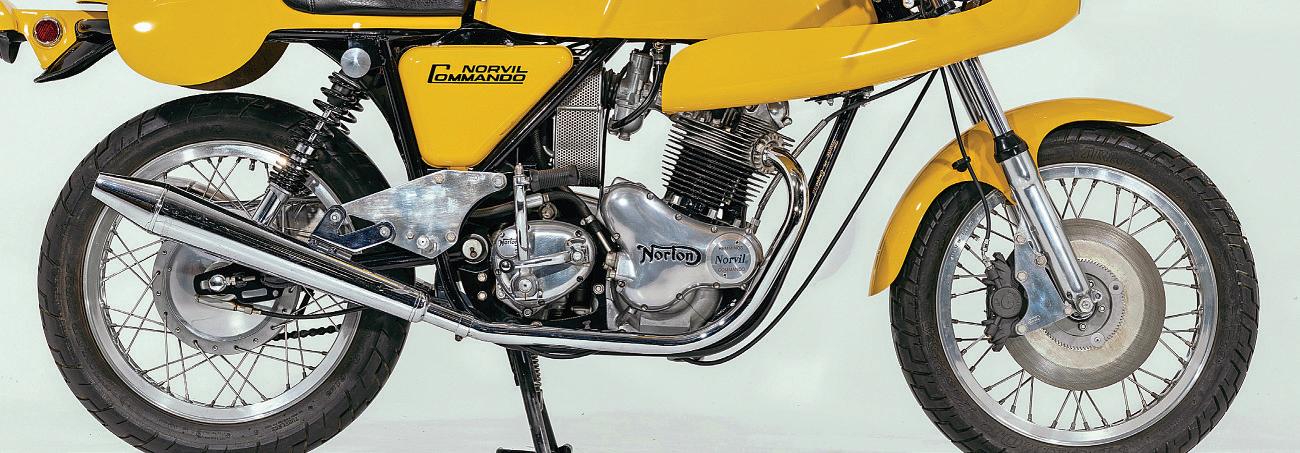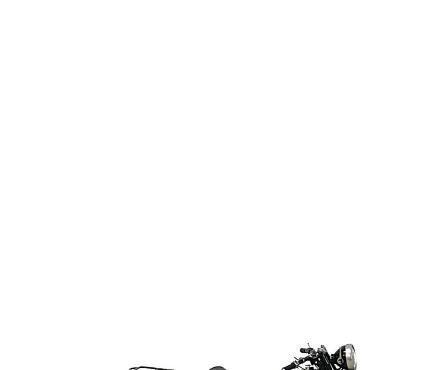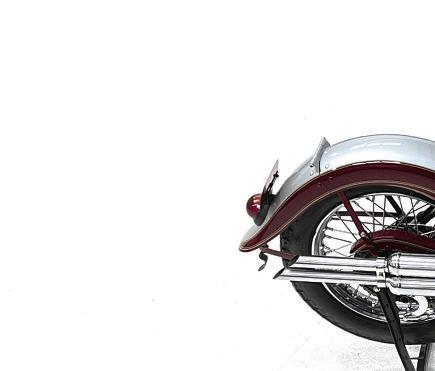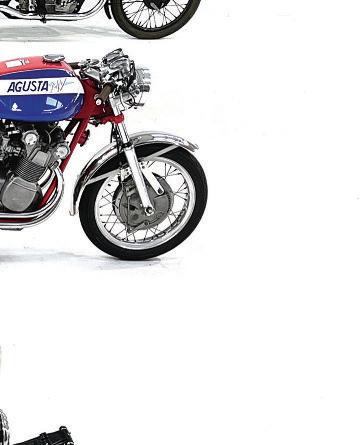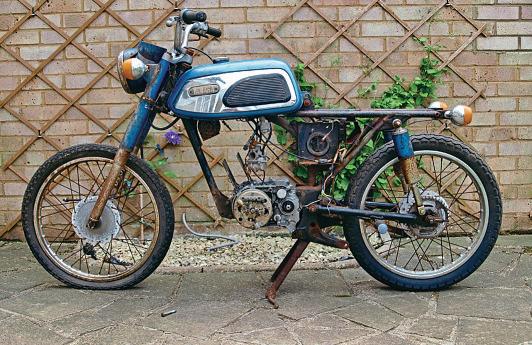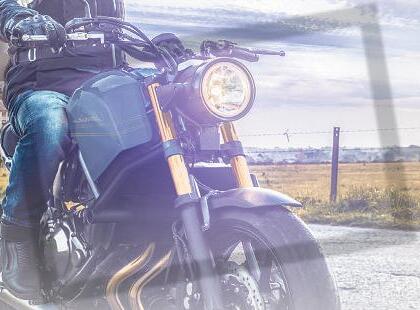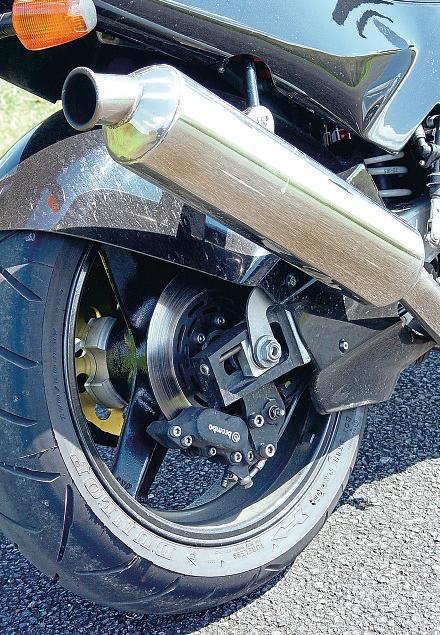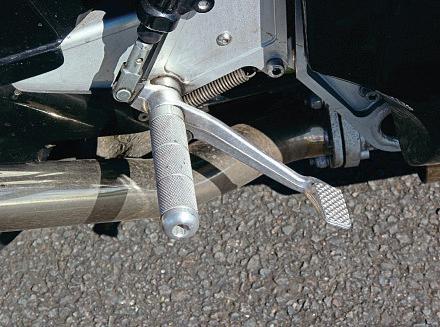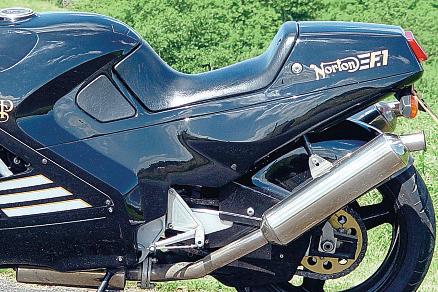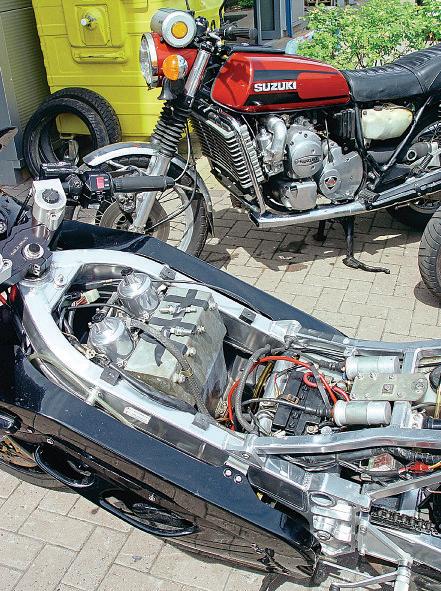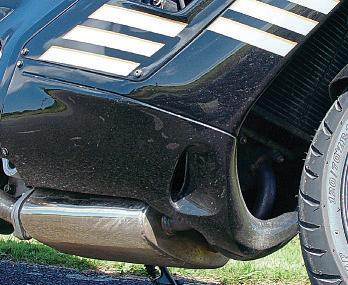The sun hasgot his haton,
hip, hip,hip,hooray…
May your projects be progressing, your tyres be free of cracks, and your sumps not a’ flling. The sun is out! So last weekend,Maria,Butchand Isqueezed into all thethermals the Army Navy Storehad and ventured up to ‘Sunny Hunny’ Hunstanton. We found thatpeople from all over the countryhad thought the same.The front wasfull of two-wheeled wonders, including alovelyred BSA A10, and though chilly, the donuts made up for it. It’sgood to be backriding.
And it makes adifference from last month’swhining about the saltand grit on the roads to having that wonderful feeling of feeling the sun on your face.Watching that mysterious orb give everything a sense of life is that miracleeveryyear brings.Still bloomin’ cold, though…
Money. Uglyword, the root causeof untold problems the world over,and feeder of envy.But whilewehereat Classic BikeGuide embracethe ordinarymuchof the time,this month we have been most lucky to spend time with some shiny jewels. Firstly, aVincent-HRD Rapide series A, whose frst owner,a young Mr Kentish, boughtitnew,then raced itatBrooklands between work shifts,winning his races and aGold Star for his efforts. He then went off to war. Afterwards, Mr Kentish took on suchpursuits as the Lands’ End Trial, as well as using it for everyday transport. What abike –ifonlytheycould talk! Now, this wonderful machine is up
for auction at the Staffordsale in April, estimated for rather alot of money, and I’m sure the near 90-year-old bike will have an easier life for years to come.If youget achance at the Stafford Classic Motorcycle Show, have agood ol’ look; those Series As have everything on show, and what an engine!
Youcan’ttalk top of the tree without the king of kings, the Brough Superior SS100. Alright, theychang ehands for the price of ahouse (ortwo), but the fascination surrounding them and theirmostfamous owner,Lawrence of Arabia, is one that’sgreat to read. Yes, manyare prisoners of ‘investors’ and theircollections, but just as manyare regularlyout there, touring Europe and doing what theydobest –going quickly–at100 years old! There’sa reallyactive clubscene,and despite the telephone number values nowadays, formost owners it’saboutthe bike and the history–theyare awonderfully eclectic bunch. There’shopefullygoing to be about 25 at the StaffordClassic Motorcycle Showthis April, morethan ever before –bring your sunglasses! Theymay be less money, butthis month’sguide to Norton’sCommando has got me poking the CBG latent project, seeing what needs to be bought so Ican stockpile for when the time comes. The earliest Commando will be morethan 60 years older than an SS100, but things had
progressed, and a750 or 850 will happily do what aBroughcan do,minus theworry of leaving it anywhere. And boy, it’s easier to getparts for aCommando that’sasold as me than it is parts formy19-year-old car! It’sa1973 Roadster,did 5000 miles beforebeing parkedup, it seems, only for parts to be whistled away to repair other bikes, I’m guessing, so is missing aloom, airbox, switchgear,headlamp, charging system, chain and both stands, beforeIstart thinking about looks. Yetall these parts areonthe shelffromseveral suppliers –Norton owners areverylucky! Iregularly hear much whinging about parts not being what theyusedtobe, but by rights we should be pleased we can get anyparts at all forthese oldbikes. I, for one,amgrateful. But there’sa list of things to do beforethe Commando gets started on and lists must be adhered to.But abox of shinyparts in the corner of your eye does give motivation…
Enjoythe warmer,salt-free weather, whateveryou’reriding,
Matt Hull editor@classicbikeguide.com
Norton F1
multiple-lobed rotor that whirls round and around. By 1957 he’dbuilt aprototype for NSU and demonstrated that the rotarymotor could be morecompact than aconventional internal combustionengine, while revving smoothlyand safelytoanenticinglyhighrpm Wankel’sengine also achievedanimpressive powerto-weight ratio.Following this promising beginning, automotive manufacturers have been trying to make the rotaryengine work ever since,until thedawnof the newelectric ageintroduced an entirelydifferent kind of rotary‘engine.’
In the early1970s, BSA-Triumph fgured the rotary motor might again be the next big thing,and then Norton-Villiers-Triumphdeveloped that twin-rotor project into possibly the next big thing for 1975. By 1981, amid the collapse of the old British bike industry, Norton had pretty much givenupany aspiration toward the next bigthing. It clung to the slim chance that autility machine intended forpoliceand military feets and poweredbyanair-cooled rotaryengine might keepthe companyafoat, while it developed the next generation of customer bikes
So,Norton built the air-cooled and faired Interpol 2, then the limited-edition, traditionally-styled Classic,and then the all-enclosed water-cooled Commander.You’d be forgivenfor not recognising anyofthese models: fewer than 800 were built between 1983 and 1994.
The F1, on the other hand, is instantlyrecognisable. Its racing counterpart, the RCW588, swooped to success in Formula 1in1989 with Steve Spray at the helm, attracted sponsorship from tobacco giant John Player, and went on to winthe Senior TT andthe BSB Championship.Evenifyou’reonlyatinycompany operating out of abig shed in Shenstone, it makes sense to capitalise on such racing achievementwitha customer machine
Enter the street-legal, liquid-cooled F1 in 1989, a reworked version of the RCW.The F1 adopted the
Right: And youeven gotyour owncover!
John Playerliveryofblack,gold and grey,blended with the fashionablesquareheadlight andwraparound bodywork of the day à la Bimota DB1, Ducati Paso,and even that brand-newgame changer,the Honda CBR600F
Blackwasn’tconsidered aparticularly attractive colour for asports motorcycle at the time,but the Norton’shigh-class colour scheme makes that 1980s styling seem less incongruous than it can be on the bright redbikes. The hand-crafted fbreglassbodywork hasstoodthe test of time,too; accidentaldamage aside,most F1s still exhibit their deeplustrous fnish on panels whichfttogether seamlessly.
Genuinelyhand-built with asuperb specifcation, aSpondon frame and top-quality components,the F1 is acomplete quirk of history.It’sa landmark motorcycle that is utterly unique,anastonishing achievement for anymanufacturer–never mind one on the brink of bankruptcy. Just 140 F1s were made between 1990 and1992, followedby70orsoF1Sports beforeproduction ceased in 1994.
Above Right: Top-rated brakes to stick with the Japanese rivals
Back to theplot
On the dayIrode that frstrotary Norton, parked at the factoryweretwo other test bikes, basicallythe same machine I’djust riddenbut ftted with BMW R100 RS and RT fairings –the bottom bits where the boxer’s pots stuckout had beenreplaced with slimmer plastic without the big holes.
Iasked about them and wasassured thatthe RT machine wasalreadyinservicewiththe police,and thatthe RS would surelyfollow. It didn’t, and Norton declinedtosell me anew machine for severalyears anyway,whichseemed likeanodd waytodobusiness, to be honest.
However, Idid buy anice newCommander, complete with swoopyall-envelopingSeymourPowell bodywork whichwas,ofcourse,great, and while at the factoryenjoying aservice(the bike,not me…) was offeredthe loan of an F1. Who could refuse?
Ishouldhaverefused.Rarely hasa bike Idesired so much been so impossible formetoride.I’m abig fatbloke and theF1isa race bike.The tworarelywork well together,sowhen the frstCommander wore out Iboughtanother, time passed, and Norton Motors went down the inevitable drainpipes of history. Moving on. The Better Thirdand Iwereata vast event somewhereinthe Midlands and apal rolled up on his immaculate Norton F1. Would we like aride? No,I cried. Yes, cried the Better Third.She lovedit, and told ProudOwner that should he decide to sell it… He did, we did, and it’s the bike in the pictures.
Takenfor aride
I’ve alreadyadmitted that Ireally did not enjoy the experience of riding theF1, so I’ll let Rowena,myvery ownBetter Third, to talk about the actual riding thing.
“Atlow revs you’ll wonder whatall the fuss is about. Below4000rpm the F1 is slightlyso-what; it certainly sounds weird, but its acceleration is far from wild. An F1 covers astanding quarter-mile in 12.47 seconds –almost half asecond slowerthan acontemporary CBR600F,despite the Norton having a10horsepower advantage
“Then youmeet the F1’smassive,free-fowing midrange and suddenlyyour surroundings blur into insignifcance.Anabundance of torque peaksat60lb-ft at 7500rpm, but youwon’tnotice the numbers because the rotor motor is so ridiculouslyeasy to rev. The F1’s 750/4 rivals produced less torque,and youhad to travel 2000rpmfurther up the revrange to fndit.
“That stepless, surging powerdelivery makes theF1 easier to ride on open roads than manyrace replicas of its generation: the midrangeismoreusablethan on atypical race-bredhomologationspecial. This machine doesn’trequireconstant cog-swapping
“Then youmeet the F1’s massive,free-flowing midrangeand suddenlyyour surroundingsblur into insignificance. An abundance of torque peaksat60lb-ftat7500rpm, but youwon’t notice the numbers because the rotor motor is so ridiculouslyeasytorev.”
Right: Rigid footpegs anod to track
to keepitonthe boilina tiny powerband.You’llfnd peak powerof95bhp at 9500rpm, but you’ll need to grab aglance at the clockstobecertain, because youwon’tfeel athing through the bars or footpegs. This engine genuinelyissosmooth –novibes, no powerpulses –that youcould balance a50p piece on the petrol tank whilerevving the bejaysus outof it (thelimiterwillprevent disaster by chipping in at 10,500rpm).
“Breathtakingroll-onacceleration aside,you’llbe howling aroundinfourth gear justtolisten to the awesome soundeffects from the F1’sintake and exhaust. It’sthe closest you’re ever going to getto two-wheeled jetpropulsion and isthe reason why owners arepreparedto put up with the bike’sless well-mannered behaviour aroundtown.
“Engine braking is akin to abig two-stroke or a 250/4: it’ssignifcant but notsubstantial.”
Rotortorque
Some of the F1’sunique engine components have inevitablybecomeveryscarce,but thereare afew specialists with the technical know-howwho can maintain the motor, andacoreof committedowners whooccasionallyfnance smallbatches of key components
The rotaryengine burns its oilmuchlike atwostroke does, using about alitre in athousand miles. It is sensitive to the individualbrand, so owners need to use one lubricant consistentlyorfush out the system before swapping to adifferent type.The gearboxand primarydrive use separate oils so need checking at service intervals.
As with manyrace-developed motorcycles, keeping things compact doesn’t exactlyaid airfowand the rotor motor runs hot –veryhot. Airtakes atorturous route to the carbs and arrivesatabout 100°C, and theall-encompassing bodywork hardly helps to keepthings cool. Just likethe RC30, the F1 can
become bothered in traffc andyou’llrapidlybecome accustomed to the sound of the fan kicking in. Afew F1s have been modifed with deep-coreradiators and stripped-backbodywork, but mostowners are loathe to lose the bike’soriginality.So, on ahot day at aconstant high speed you’ll need to observethe temperature gaugeand backoff the throttle when it nudges into the upper limits, but that shouldn’t trouble youatlegal speeds. Just don’tget stuckina crawling queueonascorching summer day…
The Yamaha fve-speed gearboxisslick,but its ratios aren’tideal for the F1’s95bhp output. The boxwas built to work with the FZR1000’s125bhp,leaving some wide gaps between the lowergears on the Norton. The F1 also displays the rotaryengine’sleast attractive habit of juddering on the overrun, the audibleindication of backlashinthe rotor motor’stransmission when the engine’snot under load. ‘Theyall do that, sir,’–but it does sound alarming, andyou typically notice it when slowing to astop,when youmight imagine it’s eating itsown extremelyexpensive intestines.
Making aclean getawaycan be challenging because the action of the 18-plate wetclutch leans towardsthe savage side of things,and it’s compounded by some stuttering from thepair of downdraught 34mm Mikuni carbs.The F1’s carburetion can be tricky to set up and there’s a tendencyfor the engine to hunt and grab at lowrevs, much like earlyfuel injectionsystems.
The upshot? It’sawesome on the open roads but aright prima donna at slowspeeds in traffc. When riding our ownbackfromamajor overhaul at Norton Motors, on averyhot dayand with alot of traffc, the coolingfan wasonpretty much allthe time and still the gaugedrifted into the reda lot.The answer? Slow down to 50 and let it all cool down again.Not glamorous, but agood idea.
The combination of Spondon’saluminium twinspar,perimeter frame and WP suspension provides
superlative steering and handling. It is precise and confdence-inspiring, if alittle weirdinthat theF1 has the physical feel of alitre-class hyperbike,not a titchy little 600. It’sadmirably stableinlong, sweeping corners but won’treact to the merest blink from the rider to changedirection –its 1440mm wheelbase demands moremuscle than the shorter HondaRC30, and the F1’ssteering is less intuitive anduser-friendly thanamoremodern streetbike.
Adjustableateither end for compression and rebound, the WP suspension is typicallyset softer for road use then stiffened to the maxfor trackdays. With the preload woundright down at the rear,you geta comfortablysoftride, albeit at the expense of some precision atthe front end under rapid acceleration. The USD forks retain their composure under even the heaviest brakingonsquirrely surfaces and, when new, therearshockprovided 143mm of travel –although manywill need arebuild by now. In fact. I’dbet that no orig inal unrebuilt rear shocks arestill in use.
The bikeiswell-balanced with 51/49 stationary weight distribution, but it’speculiarlyheavy for a motorcycle with an alloyframe and that supposedly lightweight engine.At185kg dry, it’s actuallyheavier than both the CBR600F and the VFR750R, withall their cylindersand pistons and such.Bythe timeyou’ve
Left: EarlyTriumph Daytona, anyone?
Left: Clockslook like anyperiod sportsbike
added oil and fuel, the race-replica F1isactually10kg heavier than the mass-market CBR.
F1s can be sensitivetotyrechoice, andcertainly didn’tappreciate the Dunlops ftted when new, but as the 170/60 rear tyresits on a17-inchrim youhavea decent rangeofrubber tochoosefrom.
Take great careoverspeed humps. The F1’s175mm ground clearance evaporates whenthe expensive/ irreplaceablestainless steel exhaust collector box senses an opportunity to generate aspectacular showerofsparks.
Stopping is good, though. Reallygood. The triple Brembo set-up is morethan amatchfor the F1’smass andmomentum, and the dualdiscs with their four-
piston calipersprovide substantial stoppingpower.At high speeds, the brakes arebrilliant.
Around town –especiallyasBrembo’sfoating mechanism ages –they’reamixed blessing. Wear and tear on the discs’ securing pins, combined with the 30-odd year-old discs warping, generates an oscillation in low-speed braking that adds to theF1’s fnickity traffc manners. No ABS,remember, so don’t be caught outbyasudden judder at agreasyjunction.
Does anyone expect to be comfortable on aracerep? I’ve alreadysaid that Itrulydid not like it, but Rowena felt at home and comfortable. Once again, the odd Norton proved to be alittleconfusing, the F1 feeling morelike abig sportsbikethana compact RR
Right: All encasing bodywork wasen vogue, but didn’t help cooling
Right: Robert Dunlop went well, even in the wet
Left: Steve Spray mastered the rotary
Left: The white chargerthat won the Senior in ‘92
Right: Limited-run Norton Classic
by offering asurprisinglyroomyridingposition –yet onecombined with areasonably lowsaddle height of just 760mm. There’sadequate space to shuffe around between the forward-positioned handlebars and rearwardfootrests. Even so,it’sinevitablymore comfortableatspeed than tooling around town when the rider’sweightrests on the wrists. And in town you’regoing to getashot and bothered as the engine
The windscreen works perfectlyifyou adopta racing crouch, but in normal riding your head and hands willbeexposed to anything the elements throw at you. Does all this soundjusta little negative?
Right: Frank and Rowena’s bike getting major surgery
Right: It really wasarace bike
Left: Modifedcarbs and airbox–note rival RE5 and spareplugs!
Ifear that Icome from aworld whereIexpect to be abletouse my Number One Motorcycle for just about anything, so the F1 wasjust an indulgence, really, and ended up parked in aVacBaguntilafriend in the trade madeanon-refusable offer.A dream machine? Yes, but actually abrilliant example of truly radical engineering.I know acoupleof F1 owners whocovered thousandsofmiles, andone whowent touring, with bags strapped to the seathump.
Backwhen the F1 wasofferedfor sale,a price tag of £12,700 put it beyond the reachof most British motorcyclists,but it wasn’tespeciallyextreme for that class of exclusive machine –Yamaha’sOW01retailed at £13,700, while aBimota would cost afair bit more depending on spec. Honda’sRC30 /VFR750R wasa chunk cheaper at £10,600 new, but therewere3000 of the things in circulation, not140.
So,you might thinkthatanF1wouldtodaybe worth far morethan anRC30, but that’snot how things have shaken out. You’ll paymuchthe same for either machine: at least £20,000 and half as much again for aminter.Thereare manymoreHondasto peruse,ofcourse; just one or twoF1s areoffered for sale eachyear,usuallyatauction. Youneed to be keentobuy one… but youmightjust love it to bits, of course.
It’seasy to fnd fault with the F1, and to sneer at its shortcomings. Most modern middleweight roadsters could run rings aroundit–but that’smissing the point. In its day, the limited-edition F1 wasjudged against the best that the industrygiantsinJapan andItalycould build, and it stoodupwelltosuch comparisons.
SPECIFICATION
Norton F1 specs
New price: £12,700 in 1990
Current value: : £20,000+
Capacity: 588cc
Bore xstroke: N/A
Engine layout: Twin rotor
Engine details: Liquid-cooled rotary
Power: 94bhp @9500rpm
Torque: 60lb-ft @7500rpm
Top speed: 155mph
Transmission: Five-speed, chain drive
Average fuel consumption: 37mpg claimed
Tank size: 20 litres
Frame: Aluminium twin-sparperimeter
Front suspension: 43mm WP USD
Front suspension adjustment: Compression and damping
Rear suspension: Monoshock, box-section aluminium swinging arm
Rear suspension adjustment: Preload, compression, damping
Front brake:: Twin 320mm Brembo floating discs, four-piston calipers
Rear brake: 230mm Brembo disc
Front tyre: 120/70 R17
Rear tyre: 170/60 R17
Rake/trail: 25 degrees /99mm
Dimensions: 2060mm x740mm x1130mm
Wheelbase: 1440mm
Ground clearance: 175mm
Seatheight: 760mm
Kerb weight: 215kg
These days it’saone of akind,a trulyinnovative engine in astunning chassis. It happenstobeabit rough around the edges –whichinclassic circles is generallydescribed as ‘character.’ Owning one and riding it well requires some commitment, but an F1 is the kind of bike whichinspires dedication among those people who learntoloveit.
“So, youmight think that an F1 would todaybeworth farmorethanan RC30, but that’s not howthings have shakenout. You’ll paymuch the same foreither machine:atleast £20,000 and halfasmuch againfor aminter.”





















































